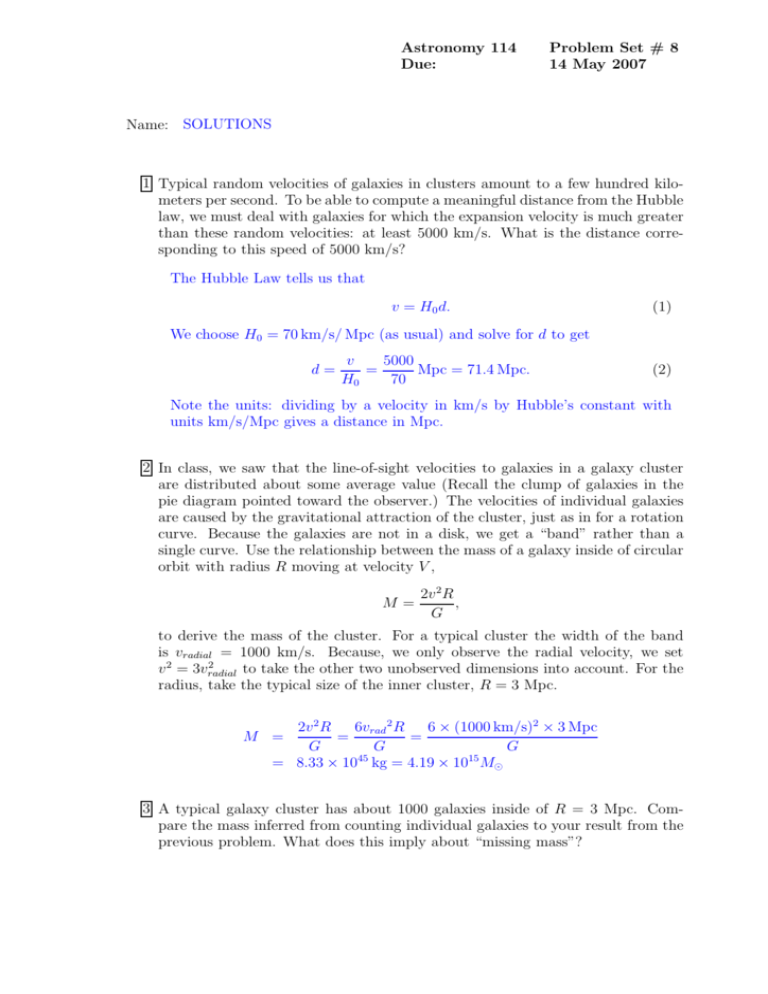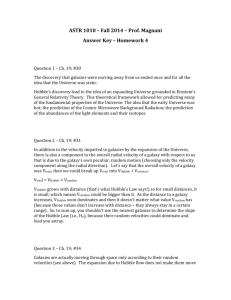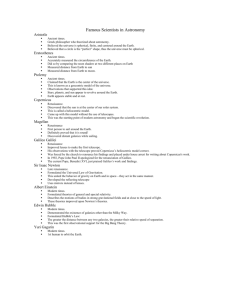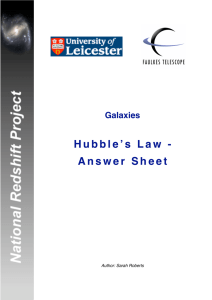solutions - UMass Astronomy
advertisement

Astronomy 114 Due: Problem Set # 8 14 May 2007 Name: SOLUTIONS 1 Typical random velocities of galaxies in clusters amount to a few hundred kilometers per second. To be able to compute a meaningful distance from the Hubble law, we must deal with galaxies for which the expansion velocity is much greater than these random velocities: at least 5000 km/s. What is the distance corresponding to this speed of 5000 km/s? The Hubble Law tells us that v = H0 d. (1) We choose H0 = 70 km/s/ Mpc (as usual) and solve for d to get d= v 5000 = Mpc = 71.4 Mpc. H0 70 (2) Note the units: dividing by a velocity in km/s by Hubble’s constant with units km/s/Mpc gives a distance in Mpc. 2 In class, we saw that the line-of-sight velocities to galaxies in a galaxy cluster are distributed about some average value (Recall the clump of galaxies in the pie diagram pointed toward the observer.) The velocities of individual galaxies are caused by the gravitational attraction of the cluster, just as in for a rotation curve. Because the galaxies are not in a disk, we get a “band” rather than a single curve. Use the relationship between the mass of a galaxy inside of circular orbit with radius R moving at velocity V , M= 2v 2 R , G to derive the mass of the cluster. For a typical cluster the width of the band is vradial = 1000 km/s. Because, we only observe the radial velocity, we set 2 v 2 = 3vradial to take the other two unobserved dimensions into account. For the radius, take the typical size of the inner cluster, R = 3 Mpc. 6vrad 2 R 6 × (1000 km/s)2 × 3 Mpc 2v 2 R = = M = G G G = 8.33 × 1045 kg = 4.19 × 1015 M⊙ 3 A typical galaxy cluster has about 1000 galaxies inside of R = 3 Mpc. Compare the mass inferred from counting individual galaxies to your result from the previous problem. What does this imply about “missing mass”? Pick the typical mass for an individual galaxy (1010 M⊙ from the Table in Freedman and Kaufmann is a good choice). The total mass of 1000 galaxies is about 1013 M⊙ . Now compare to the result of previous problem: it is only 0.01 (or 1%) of cluster mass. The missing mass implies that there must be some other mass in the clusters besides the galaxies which we call dark matter. 4 The most distant quasars have z > 5. What is the recession velocity for a z = 5 quasar? For large z, we must use a proper cosmological model. However, for an estimate, we may use the relativistic Doppler shift: z= v u u 1 + v/c t 1 − v/c − 1. (3) The precise form of this relation depends on the amount of mass and energy in the Universe through a solution of Einstein’s equations. However, this formula, true for Ω = 0, gives the basic idea. Solving for v/c (see your textbook or lecture notes) gives (z + 1)2 − 1 35 v/c = = 2 (z + 1) + 1 37 or v= 35 c = 2.84 × 105 km/s 37 (4) (5) 5 Estimate the age of the Universe for Hubble constant of (a) 50 km/s/Mpc (b) 75 km/s/Mpc and (c) 100 km/s/Mpc. On the basis of your answers, explain how the ages of globular clusters could be used to place a limit on the maximum value of the Hubble constant. The Hubble time is t = 1 . H0 For each value of Ho , we have: a). t = 6.18 × 1017 s = 1.96 × 1010 yrs b). t = 4.12 × 1017 s = 1.31 × 1010 yrs c). t = 3.09 × 1017 s = 0.98 × 1010 yrs This illustrates that the larger the value of Ho , the smaller the value of the Hubble time. Recall that the Hubble time is an over estimate for the age of the Universe (make sure you know why!). Globular clusters are the oldest objects that we observed in the universe, so the age of universe must be larger than the age of the globular clusters. Although the exact age of globular clusters is not certain (as we discussed in class), the typical main-sequence turn-off lifetime of 1.4 × 1010 yrs suggests that Ho must be 75 km/s/ Mpc or smaller. 6 When we observe a quasar with redshift z = 0.75, how far into its past are we looking? If we could see that quasar as it really is right now (that is, if the light from the quasar could somehow reach us instantaneously), would it still look like a quasar? Explain why or why not? This is a question about Lookback Time. The speed of light (3 × 105 km/sec) is fast, but finite. In our own experience, phone calls are nearly but not quite instantaneous. However, the astronomical distance of a parsec, which is 3.26 light years. This means: light must travel for 3.26 years to cover one parsec. Distance between galaxies are measured in hundreds of millions of light-years. Thus, the time for light to travel from distance galaxies is on the order of hundreds of millions of years up to billions of years for the most distant objects. Using Hubble’s expansion relation: v = Ho d → z = v Ho d = . c c The time to travel distance d is therefore: T = d z . = c Ho Using Ho = 70 km/s/Mpc and z = 0.75 we can estimate that the photon that we see from the quasar must have been emitted at the time T in the past: 0.75 = T = Ho I say estimate because this simple assumption that Ho is constant in time is not true over the age of the Universe. A better approximation must take into account a cosmological model that balances expansion and gravity. The lookback time versus redshift for the model currently preferred by astronomers (solid line) and the zero cosmological constant model (dashed line). Note that both agree for small value of redshift. 7 Explain what is meant by the observable universe. The observable universe is the volume of space centered on the observer’s position (the Earth for example), that is small enough that enough time has elapsed that the observer can observe all objects in it. In other words, enough time has elapsed since the Big Bang that that light emitted by an object to arrive at the observer. Every position in the Universe has its own observable universe which may or may not overlap with the one centered around the Earth. Note that observable in this context is an abstract concept, a sort of thought experiment: a distant point is observable if a photo could travel from that point could in principle be observed independent of any intervening material or whether or not the observer has the technology to detect it. 8 If the Universe continues to expand forever, what will eventually become of the cosmic background radiation? Recall that the frequency of photons decreases inversely with the expansion factor, R. Therefore as the Universe expands, the temperature of the cosmic background radiation decreases according to Wien’s Law. Similarly, the volume of the Universe increases as R3 . So the energy density of the cosmic background radiation will continue to decrease as the fourth power of the expansion factor. At infinite time, the temperature and energy density of the cosmic background radiation will be zero! 9 What is dark energy? Describe two ways that we can infer its presence. dark energy is a hypothetical form of energy that permeates all of space and tends to increase the rate of expansion of the universe. The idea of dark energy was invented to explain recent observations that the Universe appears to be expanding at an accelerating rate. In the standard model of cosmology, dark energy currently accounts for almost three-quarters of the total energy of the Universe. Evidence for dark energy comes in two ways: (a) Measurements of Type Ia supernovae allow us to measure the scale factor R as a function of time, assuming that Type Ia supernovae are standard candles. These observations indicate that the expansion of the Universe is not decelerating, which would be expected for a matter-dominated universe, but rather is accelerating! These observations are explained by postulating a kind of energy with that opposes gravitationally attraction (this is sometimes called negative pressure. (b) Measurements of the cosmic microwave background (CMB), most recently by the WMAP satellite, indicate that the universe is very close to flat. For the shape of the universe to be flat, the mass/energy density of the Universe must be equal to a certain critical density. The total amount of matter in the Universe (including baryons and dark matter), as measured by the CMB, accounts for only about 30% of the critical density. This implies the existence of an additional form of energy to account for the remaining 70%. 10 Use Wien’s law to calculate the wavelength at which the cosmic microwave background, as currently observed, is most intense. Wien’s law may be applied to any source of blackbody radiation to estimate the wavelength or frequency of the radiation peak. Recall that: λpeak = 0.29 cm . T ◦ (K) The temperature of the Big Bang background radiation is about 3 K (actually 2.7 K), so the microwave background of the sky peaks in power at 0.29 cm K / 2.7 K = just over 1 mm wavelength in the microwave spectrum. Although 1 mm is much smaller than the multiple centimeter wavelength of broadcast TV, the cosmic blackbody radiation has enough power to measurably contribute to TV static.








